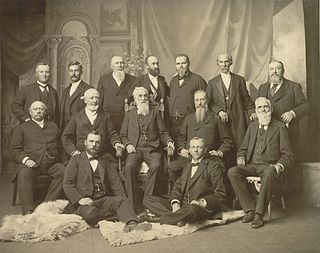
Excommunication or disfellowshiping is an institutional act of religious censure used to end or at least regulate the communion of a member of a congregation with other members of the religious institution who are in normal communion with each other. The purpose of the institutional act is to deprive, suspend, or limit membership in a religious community or to restrict certain rights within it, in particular, those of being in communion with other members of the congregation, and of receiving the sacraments.

In the Church of Jesus Christ of Latter-day Saints, the Quorum of the Twelve Apostles is one of the governing bodies in the church hierarchy. Members of the Quorum of the Twelve Apostles are apostles, with the calling to be prophets, seers, and revelators, evangelical ambassadors, and special witnesses of Jesus Christ.
A stake is an administrative unit composed of multiple congregations in certain denominations of the Latter Day Saint movement. The name "stake" derives from the Book of Isaiah: "enlarge the place of thy tent; stretch forth the curtains of thine habitation; spare not, lengthen thy cords, and strengthen thy stakes". A stake is sometimes referred to as a stake of Zion.
A ward is a local congregation in the Church of Jesus Christ of Latter-day Saints --with a smaller local congregation known as a branch.

Sylvester Quayle Cannon was an American businessman, engineer, and religious leader who served as the sixth presiding bishop of the Church of Jesus Christ of Latter-day Saints from 1925 to 1938 and a member of church's Quorum of the Twelve Apostles from 1939 until his death. He was the son of George Q. Cannon, an apostle and member of the church's First Presidency.
In the Latter Day Saint movement, patriarch is an office of the priesthood. It is considered to be either an office of the patriarchal priesthood or the Melchizedek priesthood.
In the Latter Day Saint movement, a bishop is the highest office of the Aaronic priesthood. It is almost always held by one who holds the office of high priest in the Melchizedek priesthood. The Latter Day Saint concept of the office differs significantly from the role of bishops in other Christian denominations, being in some respects more analogous to a pastor or parish priest. Each bishop serves with two counselors, who together form a bishopric.
Elder is a priesthood office in the Melchizedek priesthood of denominations within the Latter Day Saint movement, including the Church of Jesus Christ of Latter-day Saints.
In most denominations of the Latter Day Saint movement, a high priest is an office of the priesthood within the Melchizedek priesthood. High priests are typically more experienced leaders within the priesthood. The term derives in part from the Epistle to the Hebrews, which describes Jesus as "a high priest after the order of Melchizedek". Movement founder Joseph Smith ordained the first high priests on June 3, 1831.
Devin George Durrant is an American retired professional basketball player. From 1984 to 1985 he played with the Indiana Pacers and with the Phoenix Suns. He later played in European basketball leagues until 1988. In a Deseret News poll in the year 2000, he was voted one of the top 10 college basketball players in the state of Utah over the previous 100 years. In 1999, Sports Illustrated listed him as one of the 50 greatest Utah sports figures.
Sexuality has a prominent role within the theology of the Church of Jesus Christ of Latter-day Saints, which teaches that gender is defined in the premortal existence, and that part of the purpose of mortal life is for men and women to be sealed together, forming bonds that allow them to progress eternally together in the afterlife. It also teaches that sexual relations within the framework of opposite-sex marriage are healthy, necessary, and ordained of God.

Joseph Leopold Wirthlin was the eighth presiding bishop of the Church of Jesus Christ of Latter-day Saints.

Victor Lee Brown was the tenth Presiding Bishop of the Church of Jesus Christ of Latter-day Saints from 1972 to 1985. He was an LDS Church general authority from 1961 until his death.
The Presiding Bishop of the Church of Jesus Christ of Latter-day Saints is a priesthood calling with church-wide authority. The Presiding Bishop is the highest leadership position within the church's Aaronic priesthood.
An organization is a secondary body of church government within the Church of Jesus Christ of Latter-day Saints that is "established for moral, educational, and benevolent purposes." Prior to October 2019, the church's organizations were called auxiliary organizations. As the term suggested, the LDS Church's organizations are ancillary to the governing power of the priesthood in the church. The LDS Church's five organizations are Primary, Relief Society, Sunday School, Young Men, and Young Women.
The General Handbook: Serving in The Church of Jesus Christ of Latter-day Saints is an on-line book of instructions and policies for leaders and members of the Church of Jesus Christ of Latter-day Saints. The contents are prepared by the church's First Presidency and Quorum of the Twelve Apostles. Along with the church's standard works, the General Handbook stands as the preeminent policy and practice guide for the leaders of the LDS Church.
Setting apart is a ritual or priesthood action in the Church of Jesus Christ of Latter-day Saints where a person is formally blessed to carry out a specific calling or responsibility in the church.

Orrin Porter Miller was a member of the presiding bishopric of the Church of Jesus Christ of Latter-day Saints from 1901 to his death.
Stake and ward councils are meetings of local congregations within the Church of Jesus Christ of Latter-day Saints.

David LeRoy Beck was the 21st Young Men General President of the Church of Jesus Christ of Latter-day Saints from 2009 to 2015.





